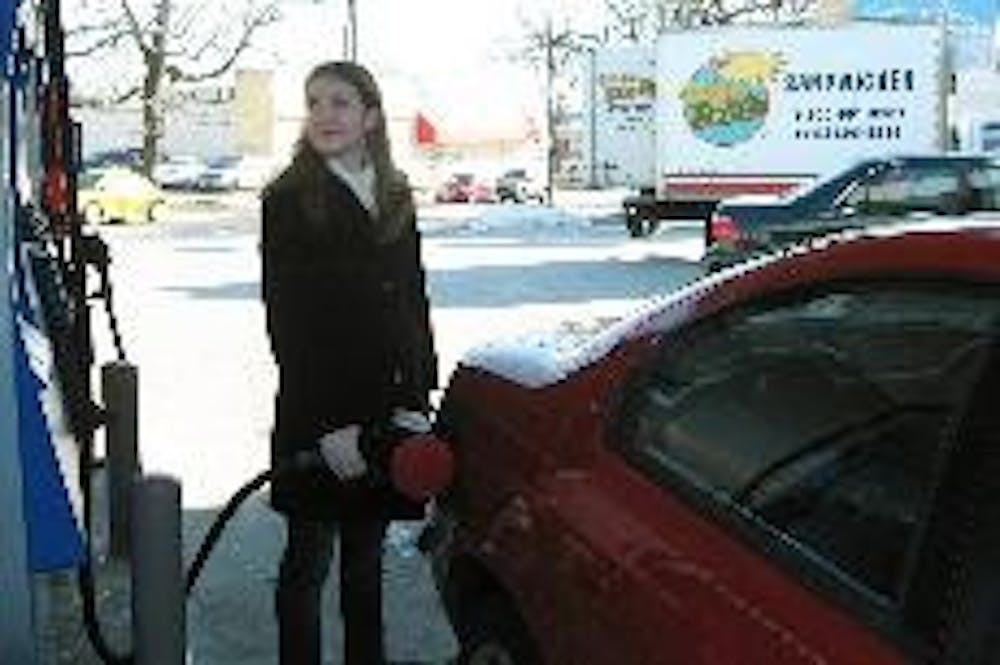
First-year Amy Schumacher fills her gas tank at United Dairy farms in Oxford. Some filling stations in the Cincinnati area have also begun offering ethanol. (Amanda Baker)
While high gas prices and America's dependence on foreign oil are major topics of discussion at the national level, drivers in Butler County will be able to experience alternative sources of energy locally with the availability of ethanol, or E-85.
Ethanol is a grain alcohol that is produced when distilled from fermented corn grain. Corn is the key ingredient because it is the most plentiful and economically available.
The ethanol-based fuel, called E-85, is becoming available at local gas stations around Butler County. According to the Greater Ohio Ethanol Web site, E-85 is a blend of 85 percent ethanol and 15 percent gasoline. It burns cleaner than regular fuels and is a renewable domestic energy source.
Jim VanKuren, an aerodynamics faculty member at Miami University, said that the ethanol fuel helps protect the environment in the sense that the nitrogen output is lower than gasoline. However, due to this lower nitrogen output, VanKuren said ethanol adds more carbon dioxide to the atmosphere than gasoline.
E-85 also puts out 30 percent less heating value than normal gasoline. Subsequently, the miles per gallon decreases, causing consumers to fill up more often, according to VanKuren.
"From an energy standpoint, the heating value of ethanol is lower than that of gasoline," VanKuren said. "When you get 30 percent less gasoline per gallon, this is not going to encourage consumers to buy the E-85."
While some gas stations in the Cincinnati area have begun offering E-85 as an option, VanKuren said he does not see it becoming available at pumps in Oxford for a long time.
"E-85 will be found primarily in the big cities, especially for the next five to 10 years," he said. "It really depends on whether or not gas companies can make a reasonable large profit, and I don't see that happening in Oxford."
The closest gas station to Oxford that sells E-85 is the Kroger in Finnytown, a suburb of Cincinnati, according to the National Ethanol Vehicle Coalition's Web site. The gas station began to offer E-85 Jan. 22 at a lower price than gasoline - $1.65 per gallon, compared to $1.91 for unleaded gasoline the same day.
According to Geoff Covert, president of the Cincinnati/Dayton division of Kroger, the store decided to offer ethanol because recently more drivers have become able to use it.
Enjoy what you're reading?
Signup for our newsletter
"The number of vehicles capable of using both traditional gasoline and E-85 is increasing in our area," Covert said.
Covert said he anticipates a broader interest in E-85 as consumers become more informed of its benefits. He said that a second Kroger location offering E-85 opened Jan. 25 in Blanchester, Ohio, and two other locations in Hyde Park and Dent will be opening in the coming weeks.
The ethanol blend is safe for cars that are E-85 friendly, which are many newer models, especially sport utility vehicles (SUVs). Known as "flex-fuel" cars, these can take E-85 or regular gasoline, according to the Greater Ohio Ethanol's Web site.
Greater Ohio Ethanol also reported that by blending up to 10 percent ethanol with gasoline, harmful exhaust emissions are decreased by more than 30 percent.
However, the problems of ethanol production include high production costs, high energy required to produce it and lower energy content, VanKuren said.
According to the United States Department of Energy, Ohio is sixth out of 50 states in total energy consumed, fourth in use of electricity, and the fourth largest industrial energy user in the U.S.




